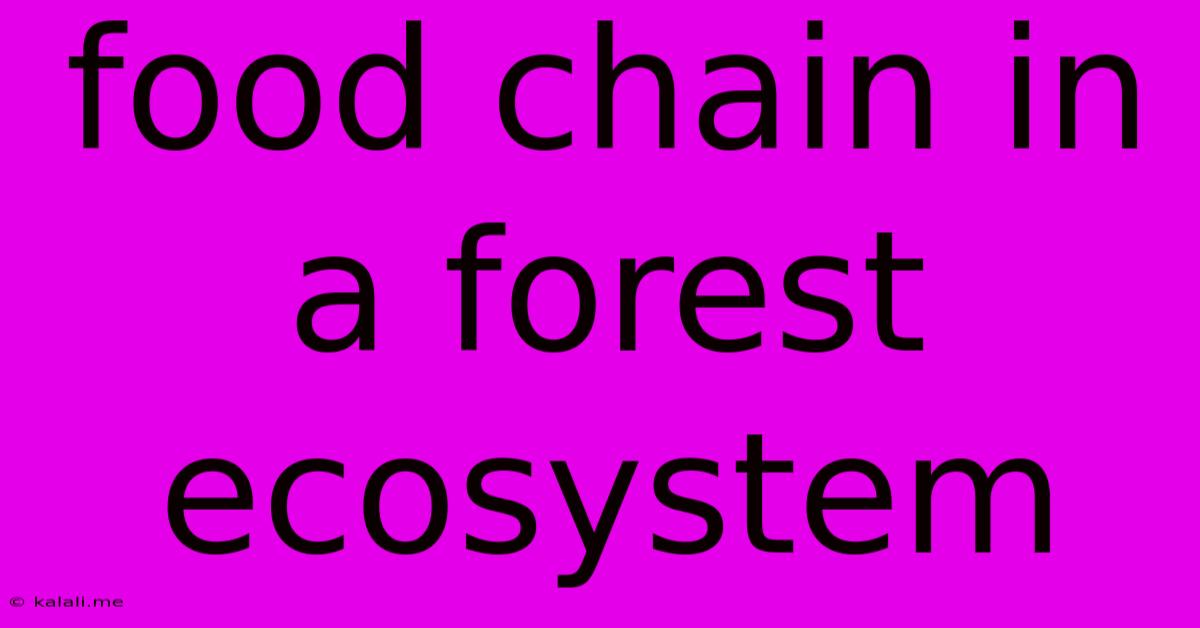Food Chain In A Forest Ecosystem
Kalali
May 10, 2025 · 3 min read

Table of Contents
Understanding the Forest Food Chain: A Complex Web of Life
The forest ecosystem, a vibrant tapestry of life, thrives on a complex network of relationships, primarily defined by its food chain. This article delves into the intricacies of the forest food chain, exploring its various trophic levels, key players, and the delicate balance that sustains it. Understanding this intricate system is crucial to appreciating the overall health and resilience of our forests.
What is a Food Chain?
A food chain illustrates the linear flow of energy and nutrients within an ecosystem. It begins with producers (autotrophs), organisms that create their own food, usually through photosynthesis, and ends with apex predators, organisms at the top of the chain with few or no natural predators. Each link in the chain represents a trophic level, indicating the organism's position in the feeding hierarchy.
Trophic Levels in the Forest Food Chain:
-
Producers (Level 1): These are the foundation of the forest food chain. They include trees, shrubs, grasses, and other photosynthetic plants. These autotrophs convert sunlight into energy through photosynthesis, producing the organic matter that fuels the entire ecosystem. Examples include oak trees, ferns, and wildflowers. Their biomass forms the base of the energy pyramid.
-
Primary Consumers (Level 2): These are herbivores, animals that feed directly on producers. This includes a wide range of creatures, from insects like caterpillars and beetles consuming leaves, to larger mammals like deer and rabbits grazing on vegetation. They are vital in transferring energy from plants to higher trophic levels.
-
Secondary Consumers (Level 3): These are carnivores (meat-eaters) that prey on primary consumers. Examples include small mammals like foxes and weasels, birds of prey like owls and hawks, and reptiles like snakes. They play a crucial role in controlling herbivore populations.
-
Tertiary Consumers (Level 4): These are top predators that feed on secondary consumers. In a forest ecosystem, this level might include larger mammals such as wolves or bears. They are essential in maintaining the balance of the ecosystem.
-
Decomposers (Level 5): While not always explicitly included in a linear food chain diagram, decomposers are critical. Bacteria, fungi, and other detritivores break down dead organic matter – plants, animals, and waste – returning essential nutrients to the soil. This nutrient cycling is essential for the continued growth of producers and the overall health of the ecosystem. Without decomposers, the forest would be choked with dead organic matter.
Interconnectedness and Food Webs:
It's important to note that the forest food chain is rarely as simple as a linear progression. In reality, it's a complex food web, with numerous interconnected food chains. Many organisms occupy multiple trophic levels, consuming a diverse diet. For instance, a fox might eat both rabbits (primary consumers) and mice (which might eat seeds and insects). This complexity increases the resilience of the ecosystem. The loss of one species doesn't necessarily collapse the entire system.
Impact of Human Activity:
Human activities, such as deforestation, habitat fragmentation, and pollution, significantly disrupt the delicate balance of the forest food chain. These disruptions can lead to population declines, extinctions, and overall ecosystem instability. Conservation efforts aimed at protecting biodiversity are critical to maintaining the health and functionality of forest ecosystems.
Conclusion:
The forest food chain is a remarkable example of interconnectedness and interdependence. Understanding its complexity is key to appreciating the vital role each organism plays in maintaining the health and productivity of the forest ecosystem. Protecting biodiversity and mitigating human impacts is crucial to preserving this complex and dynamic web of life for future generations.
Latest Posts
Latest Posts
-
Why Did The Obtuse Angle Go To The Beach
Jul 03, 2025
-
How Much Is Three Quarts Of Water
Jul 03, 2025
-
How Tall Is A 3 Story Building
Jul 03, 2025
-
Is Miranda Cosgrove Related To Jimmy Fallon
Jul 03, 2025
-
What Is 1 4 Of A 1 4 Cup
Jul 03, 2025
Related Post
Thank you for visiting our website which covers about Food Chain In A Forest Ecosystem . We hope the information provided has been useful to you. Feel free to contact us if you have any questions or need further assistance. See you next time and don't miss to bookmark.